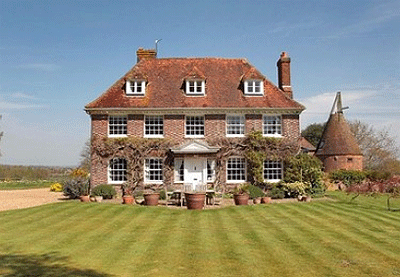Postern Heath, for sale with Chesterton Humberts, is situated amongst open fields and vineyards on the outskirts of Tonbridge. The interior features exposed timbers dating back to the 17th century, and possibly earlier, while the symmetrical Queen Anne facade creates a picturesque country house appearance. The house is believed to have been built by Thomas Weller, who was directly involved in a renowned Civil War skirmish at Tonbridge Castle. For a short time in the 1960s the house was also home to Mrs Heinz connected to the renowned Heinz Company.
The house is situated in an area known as Postern Park, formerly attached to Tonbridge Castle, which was first constructed after the Battle of Hastings in 1066. Almost 500 years later, in 1521, a survey of the estate clearly shows Postern Park attached to Tonbridge Castle, at that time owned by Edward Stafford, Duke of Buckingham. By 1542, it had passed to Sir Ralph Vane, who fell victim to the intrigues of the Tudor Court and was executed at Tower Hill in 1552. In 1553, Queen Mary I gave Postern Park to Henry Nevill, 6th Baron Bergavenny and by 1574 it was ‘disparked’ and available to lease for the first time.
By the 1670s, the area where Postern Heath is situated today was referenced in an historic document as owned by the Earl of Sterline and occupied by Thomas Weller, who had also acquired Tonbridge Castle by this time. Weller is most remembered for his involvement in an uprising at Tonbridge Castle during the Civil War in 1643. However, he is also believed to be responsible for the construction of the earlier part of Postern Heath. The Queen Anne facade was added to the house in the very early years of the 1700s and features the brick facade, sash windows, and central front door with pediment.

* Subscribe to Country Life and save 40%
The ownership and occupation of Postern Heath during the late 17th and early 18th centuries has proven difficult to establish. However, it appears that by 1728 the house was owned by John Eldridge, who left portions of the estate to his two sons. By 1759, Postern Heath is believed to have been owned by John Eldridge the younger and by 1780 had passed to James Eldridge West.
By the 1830s, Postern Heath, at this time known as Postern Farm, was still owned by James Eldridge West and was clearly shown as occupied by John Chalfield. The 1841 census later records John Chalfield was 70 years old, a farmer, and in the house with his wife Mary, also 70 years old and their unmarried daughter, 30 year old Ann. The Chalfields had one live-in servant, as well as four farm hands. At the time of the 1851 census, 80 year old John and Mary were both still at Postern Farm, recorded as 240 acres, and employing six men and six boys. Also in the house at this time were their daughter and son-in-law, Ann and John, along with a visitor and two servants.
By the 1860s, Postern Heath was known locally as ‘Mr Waite’s Farm’ and was the home of William Waite and his family. The Waite family had lived in the area of Postern for many years and at the time of the 1861 census William’s mother, widowed Frances Waite and a further six children, were living at nearby Postern Park Farm. By 1881, Postern Heath had become the home of one of William’s brothers, James Waite, who remained in the house throughout the 19th century into the early years of the 1900s. At the time of the 1901 census James was in the house with his wife Felicia, his two children John and Margaret, as well as a governess, cook and a groom.
By the time of the 1911 census, James and his family had moved to Postern Park Farm and Postern Heath had become the home of a young farmer, Harold Arthur Reeves. In 1913, the entire Postern estate was placed on the market, and Postern Heath was listed as ‘Postern Heath Farm’ and described as ‘The Most Attractive Georgian Farmhouse’. Tenants were given the option to purchase their homes, and Harold Reeves took this option and he lived in the house until 1934 when it passed to his son, Pat Reeves. By the early 1960s, Pat Reeves had passed away and the house had been purchased by Mrs Heinz, wife of Jack Heinz of the world-famous Heinz Company. However, Mrs Heinz did not stay long and by 1965 she had sold the house.
* More details on Postern Heath
* To read the full history visit my blog – The House Historian




